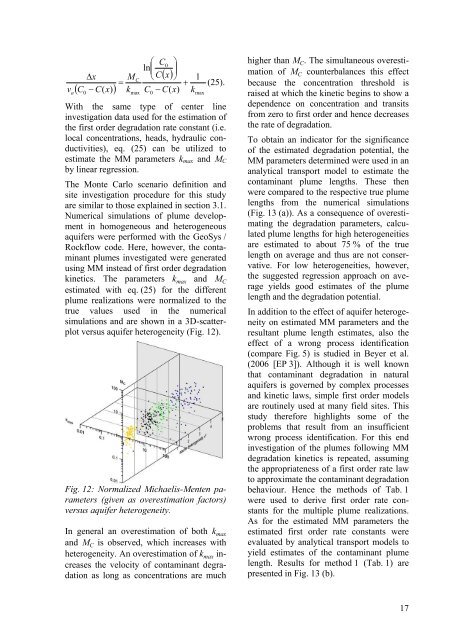Applied numerical modeling of saturated / unsaturated flow and ...
Applied numerical modeling of saturated / unsaturated flow and ...
Applied numerical modeling of saturated / unsaturated flow and ...
You also want an ePaper? Increase the reach of your titles
YUMPU automatically turns print PDFs into web optimized ePapers that Google loves.
v<br />
�<br />
�C�Cx) �<br />
� C0<br />
�<br />
ln��<br />
C�x���<br />
M � � 1<br />
�<br />
�<br />
( k C � C(<br />
x)<br />
k<br />
x C<br />
(25).<br />
a 0<br />
max 0<br />
max<br />
With the same type <strong>of</strong> center line<br />
investigation data used for the estimation <strong>of</strong><br />
the first order degradation rate constant (i.e.<br />
local concentrations, heads, hydraulic conductivities),<br />
eq. (25) can be utilized to<br />
estimate the MM parameters kmax <strong>and</strong> MC<br />
by linear regression.<br />
The Monte Carlo scenario definition <strong>and</strong><br />
site investigation procedure for this study<br />
are similar to those explained in section 3.1.<br />
Numerical simulations <strong>of</strong> plume development<br />
in homogeneous <strong>and</strong> heterogeneous<br />
aquifers were performed with the GeoSys /<br />
Rock<strong>flow</strong> code. Here, however, the contaminant<br />
plumes investigated were generated<br />
using MM instead <strong>of</strong> first order degradation<br />
kinetics. The parameters k max <strong>and</strong> M C<br />
estimated with eq. (25) for the different<br />
plume realizations were normalized to the<br />
true values used in the <strong>numerical</strong><br />
simulations <strong>and</strong> are shown in a 3D-scatterplot<br />
versus aquifer heterogeneity (Fig. 12).<br />
Fig. 12: Normalized Michaelis-Menten parameters<br />
(given as overestimation factors)<br />
versus aquifer heterogeneity.<br />
In general an overestimation <strong>of</strong> both k max<br />
<strong>and</strong> M C is observed, which increases with<br />
heterogeneity. An overestimation <strong>of</strong> k max increases<br />
the velocity <strong>of</strong> contaminant degradation<br />
as long as concentrations are much<br />
higher than MC. The simultaneous overestimation<br />
<strong>of</strong> MC counterbalances this effect<br />
because the concentration threshold is<br />
raised at which the kinetic begins to show a<br />
dependence on concentration <strong>and</strong> transits<br />
from zero to first order <strong>and</strong> hence decreases<br />
the rate <strong>of</strong> degradation.<br />
To obtain an indicator for the significance<br />
<strong>of</strong> the estimated degradation potential, the<br />
MM parameters determined were used in an<br />
analytical transport model to estimate the<br />
contaminant plume lengths. These then<br />
were compared to the respective true plume<br />
lengths from the <strong>numerical</strong> simulations<br />
(Fig. 13 (a)). As a consequence <strong>of</strong> overestimating<br />
the degradation parameters, calculated<br />
plume lengths for high heterogeneities<br />
are estimated to about 75 % <strong>of</strong> the true<br />
length on average <strong>and</strong> thus are not conservative.<br />
For low heterogeneities, however,<br />
the suggested regression approach on average<br />
yields good estimates <strong>of</strong> the plume<br />
length <strong>and</strong> the degradation potential.<br />
In addition to the effect <strong>of</strong> aquifer heterogeneity<br />
on estimated MM parameters <strong>and</strong> the<br />
resultant plume length estimates, also the<br />
effect <strong>of</strong> a wrong process identification<br />
(compare Fig. 5) is studied in Beyer et al.<br />
(2006 [EP 3]). Although it is well known<br />
that contaminant degradation in natural<br />
aquifers is governed by complex processes<br />
<strong>and</strong> kinetic laws, simple first order models<br />
are routinely used at many field sites. This<br />
study therefore highlights some <strong>of</strong> the<br />
problems that result from an insufficient<br />
wrong process identification. For this end<br />
investigation <strong>of</strong> the plumes following MM<br />
degradation kinetics is repeated, assuming<br />
the appropriateness <strong>of</strong> a first order rate law<br />
to approximate the contaminant degradation<br />
behaviour. Hence the methods <strong>of</strong> Tab. 1<br />
were used to derive first order rate constants<br />
for the multiple plume realizations.<br />
As for the estimated MM parameters the<br />
estimated first order rate constants were<br />
evaluated by analytical transport models to<br />
yield estimates <strong>of</strong> the contaminant plume<br />
length. Results for method 1 (Tab. 1) are<br />
presented in Fig. 13 (b).<br />
17

















